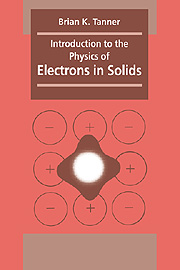Book contents
- Frontmatter
- Contents
- Preface
- Acknowledgements
- 1 The classical free electron model
- 2 Quantum mechanical free electron model
- 3 Application of the Fermi gas model
- 4 Energy bands
- 5 Experimental evidence for band structure and effective mass
- 6 Electrical conduction in semiconductors and insulators
- 7 Semiconductor devices
- 8 Localized electrons
- 9 Magnetism
- 10 Superconductivity
- Appendix 1 Elements of kinetic theory
- Appendix 2 Elements of statistical mechanics
- Appendix 3 Derivation of the Landé g factor
- Index
8 - Localized electrons
Published online by Cambridge University Press: 05 June 2012
- Frontmatter
- Contents
- Preface
- Acknowledgements
- 1 The classical free electron model
- 2 Quantum mechanical free electron model
- 3 Application of the Fermi gas model
- 4 Energy bands
- 5 Experimental evidence for band structure and effective mass
- 6 Electrical conduction in semiconductors and insulators
- 7 Semiconductor devices
- 8 Localized electrons
- 9 Magnetism
- 10 Superconductivity
- Appendix 1 Elements of kinetic theory
- Appendix 2 Elements of statistical mechanics
- Appendix 3 Derivation of the Landé g factor
- Index
Summary
In this chapter we examine the way in which the simple model of an electron in a box can be applied to understand the optical properties of the alkali halides. We then proceed to consider the magnetic properties of electrons which are localized at specific lattice sites. With this discussion of the phenomena of diamagnetism and paramagnetism, we lead up to the next chapter on magnetic order where we see the breakdown of the independent electron approximation giving quite dramatic results.
Point defects in alkali halides
The band gaps of the alkali halides, such as NaCl or KCl, are high and they are found to be excellent insulators. Thus, in the pure and perfect state, the alkali halides are transparent to visible light. However, as a result of either irradiation with X-rays, heating in the vapour of the alkali metal or electrolysis at high temperature, it is possible to create large numbers of negative ion vacancies (Fig. 8.1). These defects correspond to unoccupied lattice sites which would normally contain a halide ion. If the lattice site was simply vacant, the site would appear to be positively charged due to the removal of negative charge on the halide ion. In order to preserve electrical neutrality, it is favourable for an electron to become trapped at this negative ion vacancy. Such an electron trapped at a negative ion vacancy is called an F or colour centre.
- Type
- Chapter
- Information
- Introduction to the Physics of Electrons in Solids , pp. 166 - 180Publisher: Cambridge University PressPrint publication year: 1995



